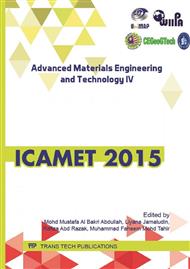p.480
p.487
p.491
p.495
p.499
p.503
p.509
p.514
p.519
Extraction and Tensile Behavior of High Performance Hibiscus tiliceus Fiber
Abstract:
Environmental awareness has created an increasing concern with the greenhouse cause and effect, it has simulated the need for a more natural and eco-friendly construction, formed from textile materials. Natural fibers seem to be a good alternative, as this research is focused upon the studies of the extraction of Hibiscus Tiliaceus fibers, found in abundance naturally. Since they are readily available and accessible in fibrous form, they can easily be extracted form the plant stem itself, which is a plant that grows naturally, with very low maintenance costs. In this research we have studied the strength of Hibiscus Tiliaceus, when extracting the fibers by hand. From this experiment, it was found that fiber was removed from the trunk of the plant, then the application of water rating could be used successfully for separating the extract fiber from the sheath of the Hibiscus Tiliaceus in turn. The microscopically longitudinal studies showed a roughness and also a flat surface in the fibers. The fiber width was recorded at 0.3 millimeter, as well as the fiber strength recorded at 651.9 denier and 10.93 newtons, respectively. There are three conditions of applications added for this natural fiber, which involve scouring and bleaching treatments.
Info:
Periodical:
Pages:
499-502
Citation:
Online since:
May 2016
Keywords:
Price:
Сopyright:
© 2016 Trans Tech Publications Ltd. All Rights Reserved
Share:
Citation:


